This is an old revision of this page, as edited by 82.32.60.14 (talk) at 14:56, 28 March 2006 (→Future of the car). The present address (URL) is a permanent link to this revision, which may differ significantly from the current revision.
Revision as of 14:56, 28 March 2006 by 82.32.60.14 (talk) (→Future of the car)(diff) ← Previous revision | Latest revision (diff) | Newer revision → (diff)An automobile is a wheeled vehicle that carries its own motor. Different types of automobiles include cars, buses, trucks, vans, and motorcycles, with cars being the most popular. The term is derived from Greek 'autos' (self) and Latin 'movére' (move), referring to the fact that it 'moves by itself'. Earlier terms for automobile include 'horseless carriage' and 'motor car'. As of 2005 there are 600 million cars worldwide (0.074 per capita), of which 220 million are located in the United States (0.75 per capita).
The automobile was hailed as an environmental improvement over horses when it was first introduced. Before its introduction, in New York City, over 10,000 tons of manure had to be removed from the streets daily.
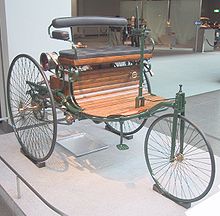
History
Main article: History of the automobileThe modern automobile powered by the Otto gasoline engine was invented in Germany by Karl Benz. Even though Karl Benz is credited with the invention of the modern automobile, several German engineers worked on building automobiles at the same time. These inventors are: Karl Benz, who was granted a patent dated January 29, 1886 in Mannheim for the vehicle he built in 1885, Gottlieb Daimler and Wilhelm Maybach in Stuttgart in 1888 (also inventors of the first motor bike), and in 1888/89 German-Austrian inventor Siegfried Marcus in Vienna, although Marcus didn't go beyond the prototype stage. Template:Automobile history eras
Steam powered vehicles
Steam-powered self-propelled cars were devised in the late 18th century. The first self-propelled car was built by Nicolas-Joseph Cugnot in 1769, it could attain speeds of up to 6 km/h (3.7 mi/h). In 1771 he designed another steam-driven car, which ran so fast that it rammed into a wall, producing the world's first car accident.
The internal combustion engine
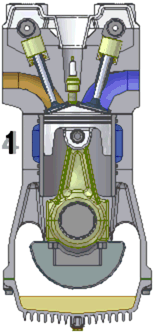
In 1806 Fransois Isaac de Rivaz, a Swiss, designed the first internal combustion engine (sometimes abbreviated "ICE" today). He subsequently used it to develop the world's first vehicle to run on such an engine that used a mixture of hydrogen and oxygen to generate energy. The design was not very successful, as was the case with the British inventor, Brown, and the American inventor, Morey, who produced vehicles powered by clumsy internal combustion engines about 1826.
Etienne Lenoir produced the first successful internal combustion engine in 1860, and within a few years, about four hundred were in operation in Paris. About 1863, Lenoir installed his engine in a vehicle. It seems to have been powered by city lighting-gas in bottles, and was said by Lenoir to have "travelled more slowly than a man could walk, with breakdowns being frequent." Lenoir, in his patent of 1860, included the provision of a carburettor, so liquid fuel could be substituted for gas, particularly for mobile purposes in vehicles. Lenoir is said to have tested liquid fuel, such as alcohol, in his stationary engines; but it doesn't appear that he used them in his own vehicle. If he did, he most certainly didn't use gasoline, as this was not well-known and was considered a waste product.
The next innovation occurred in the late 1860s, with Siegfried Marcus, a German working in Vienna, Austria. He developed the idea of using gasoline as a fuel in a two-stroke internal combustion engine. In 1870, he built a crude vehicle with no seats, steering, or brakes, but it was remarkable for one reason: it was the world's first internal-combustion-engine-powered vehicle fueled by gasoline. It was tested in Vienna in September of 1870. In 1888 or 1889, he built a second automobile, this one with seats, brakes, and steering, and included a four-stroke engine of his own design.
The four-stroke engine already had been documented and patented in 1862 by the Frenchman Beau de Rochas in a long-winded and rambling pamphlet. He printed about three hundred copies of his pamphlet and they were distributed in Paris, but nothing came of this, with the patent expiring soon after and the pamphlet disappearing into total obscurity. In fact, its existence mostly was unknown and Beau de Rochas never built a single engine.
Most historians agree that Nikolaus Otto of Germany built the world's first four-stroke engine although his patent was voided. He knew nothing of Beau de Rochas's patent or idea, and came upon the idea entirely on his own. In fact, he began thinking about the concept in 1861, but abandoned the it until the mid-1870s. There is some evidence, although not conclusive, that one Christian Reithmann, an Austrian living in Germany, had built a four-stroke engine entirely on his own by 1873. Reithmann had been experimenting with internal combustion engines as early as 1852.
In 1883, Edouard Delamare-Deboutteville and Leon Malandin of France installed an internal combustion engine powered by a tank of city gas on a tricycle. As they tested the vehicle, the tank hose came loose, resulting in an explosion. In 1884, Delamare-Deboutteville and Malandin built and patented a second vehicle. This one consisted of two four-stroke, liquid-fueled engines mounted on an old four-wheeled horse cart. The patent, and presumably the vehicle, contained many innovations, some of which wouldn't be used for decades. However, during the vehicle's first test, the frame broke apart, the vehicle literally "shaking itself to pieces," in Malandin's own words. No more vehicles were built by the two men. Their venture went completely unnoticed and their patent unexploited. Knowledge the vehicles and experiments was obscured until years later.
Supposedly in the late 1870s, an Italian named Murnigotti patented the idea of installing an internal combustion engine on a vehicle, although there is no evidence that one was built. In 1884, Enrico Bernardi, another Italian, installed an internal combustion engine on his son's tricycle. Although merely a toy, it is said to have operated somewhat successfully in one source, but another says the engine's power was too feeble to make the vehicle move.
If all of the above experiments hadn't taken place, however, the development of the automobile wouldn't have been retarded by so much as a moment, since they were unknown experiments that never advanced beyond the testing stage. The internal-combustion-engine automobile really can be said to have begun in Germany with Karl Benz in 1885 and Gottlieb Daimler in 1886, for their vehicles were successful, they went into series-production, and they inspired others.
Karl Benz began to work on new engine patents in 1878. First, he concentrated all his efforts on creating a reliable two-stroke gas engine, based on Nikolaus Otto's design of the four-stroke engine. A patent on the design by Otto had been declared void. Benz finished his engine on New Year's Eve and was granted a patent for it in 1879. Benz built his first three-wheeled car in 1885 and it was granted a patent in Mannheim, dated January of 1886. He built improved versions in 1886 and 1887 and went into production in 1888—the world's first vehicle put into production. Approximately twenty-five were built before 1893, when his first four-wheeler was introduced. They were powered with four-stroke engines of his own design. Emile Roger of France, already producing Benz engines under license, now added the Benz automobile to his line of products. Because France was more open to the early automobiles, in general, more were built and sold in France through Roger, than Benz sold initially from his own factory in Germany.
Gottlieb Daimler, in 1886, fitted a horse carriage with his four-stroke engine in Stuttgart. In 1889, he built two vehicles from scratch, with several innovations. From 1890 to 1895 about thirty vehicles were built by Daimler and his innovative assistant, Maybach, either at the Daimler works or in the Hotel Hermann, where they set up shop after having a falling out with their backers. These two Germans, Benz and Daimler, seem to have been unaware of the early work of each other and worked independantly. During the First World War, Benz suggested a co-operative effort between the companies the two founded, but it was not until 1926 that the companies united under the name of Daimler-Benz with a commitment to remain together under that name until the year 2000.
In 1890, Emile Levassor and Armand Peugeot of France began series-producing vehicles with Daimler engines, and so laid the foundation of the motor industry in France. They were inspired by Daimler's Stalhradwagen of 1889, which was exhibited in Paris in 1889.
The first American automobile with gasoline-powered internal combustion engines supposedly was designed in 1877 by George Baldwin Selden of Rochester, New York, who applied for a patent on an automobile in 1879. Selden didn't build a single automobile until 1905, when he was forced to do so, due to a lawsuit. Selden received his patent and later sued the Ford Motor Company for infringing his patent. Henry Ford was notorious for opposing the American patent system and Selden's case against Ford went all the way to the Supreme Court, which ruled that Ford, and anyone else, was free to build automobiles without paying royalties to Selden, since automobile technology had improved significantly since Selden's patent and no one was building according to his earlier designs.
Meanwhile, notable advances in steam power evolved in Birmingham, England by the Lunar Society. It was here that the term horsepower was first used. It also was in Birmingham that the first British four-wheel petrol-driven automobiles were built in 1895 by Frederick William Lanchester. Lanchester also patented the disc brake in that city. Electric vehicles were produced by a small number of manufacturers.
Innovation

The first automobile patent in the United States was granted to Oliver Evans in 1789; in 1804 Evans demonstrated his first successful self-propelled vehicle, which not only was the first automobile in the US but was also the first amphibious vehicle, as his steam-powered vehicle was able to travel on wheels on land and via a paddle wheel in the water.
In 1888, a major breakthrough came with the historic drive of Bertha Benz. She drove an automobile her husband Karl Benz had built in 1885 and patented in 1886 for a distance of 106 km or fifty miles.
On 5 November, 1895, George B. Selden was granted a United States patent for a two-stroke automobile engine (U.S. patent 549,160). This patent did more to hinder than encourage development of autos in the USA. Steam, electric, and gasoline powered autos competed for decades, with gasoline internal combustion engines achieving dominance in the 1910s.
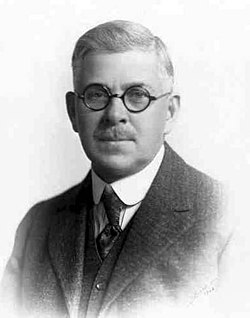
The large-scale, production-line manufacturing of affordable automobiles was debuted by Oldsmobile in 1902, then greatly expanded by Henry Ford in the 1910s. Development of automotive technology was rapid, due in part to the hundreds of small manufacturers competing to gain the world's attention. Key developments included electric ignition and the electric self-starter (both by Charles Kettering, for the Cadillac Motor Company in 1910-1911), independent suspension, and four-wheel brakes.
Model changeover and design change
Cars are not merely continually perfected mechanical contrivances; since the 1920s nearly all have been mass-produced to meet a market, so marketing plans and manufacture to meet them have often dominated automobile design. It was Alfred P. Sloan who established the idea of different makes of cars produced by one firm, so that buyers could "move up" as their fortunes improved. The makes shared parts with one another so that the larger production volume resulted in lower costs for each price range. For example, in the 1950s, Chevrolet shared hood, doors, roof, and windows with Pontiac; the LaSalle of the 1930s, sold by Cadillac, used the cheaper mechanical parts made by the Oldsmobile division.
Alternative fuels and batteries
Main article: Alternative fuel carsWith heavy taxes on fuel, particularly in Europe and tightening environmental laws, particularly in California, and the possibility of further restrictions on greenhouse gas emissions, work on alternative power systems for vehicles continues.
Diesel-powered cars can run with little or no modification on 100% pure biodiesel, a fuel that can be made from vegetable oils but require modifications if you drive in cold weather countries, the main plus of Diesel combustion engines is it's 50% fuel burn advantage over 23% in the best gasoline engines. This makes Diesel engines capable of achieving an average of 17 kilometers per liter fuel efficiency. Many cars that currently use gasoline can run on ethanol, a fuel made from plant sugars. Most cars that are designed to run on gasoline are capable of running with up to 15% ethanol mixed in. With a small amount of redesign, gasoline-powered vehicles can run on ethanol concentrations as high as 85%. All petrol fuelled cars can run on LPG. There has been some concern that the ethanol-gasoline mixtures prematurely wear down seals and gaskets. Theoretically, the lower energy content of alcohol should lead to considerably reduced efficiency and range when compared with gasoline. However, EPA testing has actually shown only a 20-30% reduction in range. Therefore, if your vehicle is capable of doing 750 kilometers on a 50 liter tank (15 kilometers per liter), its range would be reduced to approximately 600 kilometers (12 kilometers per liter). Of course, certain measures are available to increase this efficiency, such as different camshaft configurations, altering the timing/spark output of the ignition, increasing compression, or simply using a larger fuel tank.
In the United States, alcohol fuel was produced in corn-alcohol stills until Prohibition criminalized the production of alcohol in 1919. Brazil is the only country which produces pure ethanol powered cars, called Flex, since the late 1970s.
Attempts at building viable battery-powered electric vehicles continued throughout the 1990s (notably General Motors with the EV1), but cost, speed and inadequate driving range made them uneconomical. Battery powered cars have primarily used lead-acid batteries and NiMH batteries. Lead-acid batteries' recharge capacity is considerably reduced if they're discharged beyond 75% on a regular basis, making them a less-than-ideal solution. NiMH batteries are a better choice, but are considerably more expensive than lead-acid.
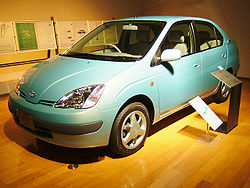
Current research and development is centered on "hybrid" vehicles that use both electric power and internal combustion. The first hybrid vehicle available for sale in the USA was the Honda Insight. As of 2005, The car is still in production and achieves around 25.5 kilometers per liter.
Other R&D efforts in alternative forms of power focus on developing fuel cells, alternative forms of combustion such as GDI and HCCI, and even the stored energy of compressed air (see water Engine).
Accidents seem as old as automobile vehicles themselves. Joseph Cugnot crashed his steam-powered "Fardier" against a wall in 1771. The first recorded automobile fatality was Bridget Driscoll on 1896-08-17 in London and the first in the United States was Henry Bliss on 1899-09-13 in New York City, NY.
Cars have two basic safety problems: They have human drivers who make mistakes, and the wheels lose traction near a half gravity of deceleration. Automated control has been seriously proposed and successfully prototyped. Shoulder-belted passengers could tolerate a 32G emergency stop (reducing the safe intervehicle gap 64-fold) if high-speed roads incorporated a steel rail for emergency braking. Both safety modifications of the roadway are thought to be too expensive by most funding authorities, although these modifications could dramatically increase the number of vehicles that could safely use a high-speed highway.
Early safety research focused on increasing the reliability of brakes and reducing the flammability of fuel systems. For example, modern engine compartments are open at the bottom so that fuel vapors, which are heavier than air, vent to the open air. Brakes are hydraulic so that failures are slow leaks, rather than abrupt cable breaks. Systematic research on crash safety started in 1958 at Ford Motor Company. Since then, most research has focused on absorbing external crash energy with crushable panels and reducing the motion of human bodies in the passenger compartment.
There are standard tests for safety in new automobiles, like the EuroNCAP and the US NCAP tests. There are also tests run by organizations such as IIHS and backed by the insurance industry.
Despite technological advances, there is still significant loss of life from car accidents: About 40,000 people die every year in the U.S., with similar figures in Europe. This figure increases annually in step with rising population and increasing travel if no measures are taken, but the rate per capita and per mile travelled decreases steadily. The death toll is expected to nearly double worldwide by 2020. A much higher number of accidents result in injury or permanent disability. The highest accident figures are reported in China and India. The European Union has a rigid program to cut the death toll in the EU in half by 2010 and member states have started implementing measures.
Current Production
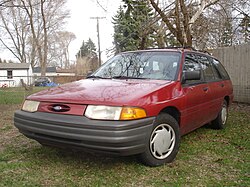
In 2005 63 million cars and light trucks were produced worldwide. The world's biggest car producer (including light trucks) is the European Union with 29% of the world's production. In non-EU Eastern Europe another 4% are produced. The second largest manufacturer is NAFTA with 25.8%, followed by Japan with 16.7%, China with 8.1%, MERCOSUR with 3.9%, India with 2.4% and the rest of the world with 10.1%. (vda-link)
Large free trade areas like EU, NAFTA and MERCOSUR attract manufacturers worldwide to produce their products within them and without currency risks or customs, additionally to being close to customers. Thus the production figures do not show the technological ability or business skill of the areas. In fact much if not most of the Third World car production is used western technology and car models (and sometimes even complete obsolete western factories shipped to the country), which is reflected in the patent statistic as well as the locations of the r&d centers.
The automobile industry is dominated by relatively few large corporations (not to be confused with the much more numerous brands), the biggest of which (by numbers of produced cars) are currently General Motors, Toyota and Ford Motor Company. It is expected, that Toyota will reach the No.1 position in 2006. The most profitable per-unit car-maker of recent years has been Porsche due to its premium price tag.
The automotive industry at large still suffers from high under-utilization of its manufacturing potential.
Future of the car
In order to limit deaths, there has been a push for self-driving automobiles. There have been many notable efforts funded by the NHTSA, including the many efforts by the NavLab group at Carnegie Mellon University. Recent efforts include the highly publicized DARPA Grand Challenge race.

A current invention is ESP by Bosch that is claimed to reduce deaths by about 30% and is recommended by many lawmakers and carmakers to be a standard feature in all cars sold in the EU. ESP recognizes dangerous situations and corrects the drivers input for a short moment to stabilize the car.
The biggest threat to automobiles is the declining supply of oil, which does not completely stop car usage but makes it significantly more expensive. Beginning of 2006 1 liter of gas costs approx. 1.6 US$ in Germany and other European countries. If no cheap solution can be found in the relatively near future individual mobility might suffer a major setback. Nevertheless, individual mobility is highly prized in modern societies so the demand for automobiles is inelastic. Alternative individual modes of transport, such as Personal rapid transit, could make the automobile obsolete if they prove to be cheaper and more energy efficient.
Hydrogen cars, driven either by a combination of fuel cells and an electric motor, or alternatively, a conventional combustion engine, are thought to replace fossil fuel powered cars in a few decades. The biggest obstacle for a mass market of hydrogen cars is the cost of hydrogen production by electrolysis, which is inefficient and requires a comparatively expensive source of electrical energy. However Hydrogen produces 5 times as much energy than 93 octane gasoline and promises to be cheaper with mass production and none CO2, but steam H2O emissions as result of the combustion. BMW's engineering team promises a high horsepower hydrogen fuel engine in it's 7-series sedan before the next generation of the car makes it's debut.

The electric car in general appears to be a way forward in principle; electric motors are far more efficient than internal combustion engines and have a much greater power to weight ratio. They also operate efficiently across the full speed range of the vehicle and develop a lot of torque at zero speed, so are ideal for cars. A complex drivetrain and transmission would not be needed. However, despite this the electric car is held back by battery technology - so far a cell with comparable energy density to a tank of liquid fuel is a long way off, and there is no infrastructure in place to support it. A more practical approach may be to use a smaller internal combustion engine to drive a generator- this approach can be much more efficient since the IC engine can be run at a single speed, use cheaper fuel such as diesel, and drop the heavy, power wasting drivetrain. Such an approach has worked very well for railway locomotives, but so far has not been scaled down for car use.
Recently the automobile industry has determined that the biggest potential growth market (in terms of both revenue and profit), is software. Cars are now equipped with a stunning array of software; from voice recognition and vehicle navigation systems to in-vehicle distributed entertainment systems (DVD/Games), to telematics systems such as GMs Onstar not to mention the control subsystems. Software now accounts for 35% of a cars value, and this percentage is only going to get larger. The theory behind this is that the mechanical systems of automobiles are now essentially a commodity, and the real product differentiation occurs in the software systems. Many cars are equipped with full blown 32bit real-time memory protected operating systems such as QNX.
Automobile ancillary power
- Ancillary power — mechanical, electrical, hydraulic, vacuum, air
- drivetrain
- transmission (gearbox)
- Layout
- Drive Wheels
- differential
- axle
- Live axle
- brakes
- wheels and tires
- steering
- suspension
- body
- crumple zones
- monocoque (or unibody) construction
- Category:Car doors
- spoiler
- Japan Black (fore-runner of modern automotive finishes)
- interior equipment
- passive safety
- dashboard
- shifter for selecting gear ratios
- ancillary equipment such as stereos, air conditioning, cruise control, car phones, positioning systems, cup holders, etc.
- exterior equipment
See also
External links
| This page or section may contain link spam masquerading as content. Spam on Misplaced Pages consists of external links mainly intended to promote a website. If you are familiar with the content of the external links, please help by removing promotional links in accordance with Misplaced Pages:External links. |